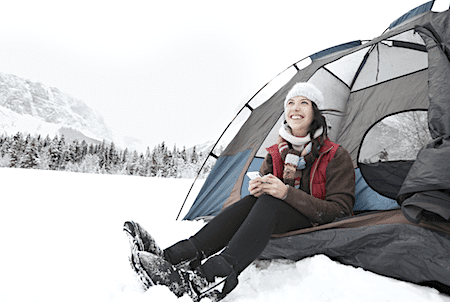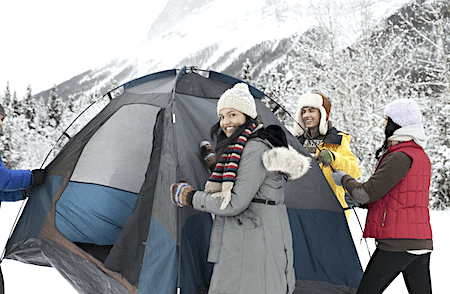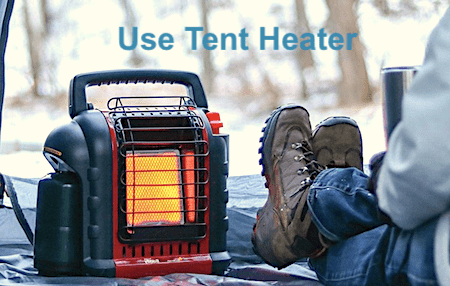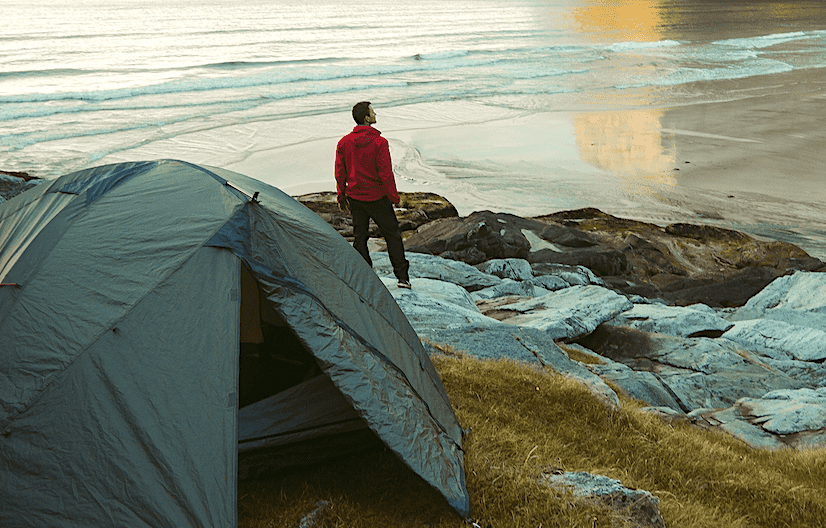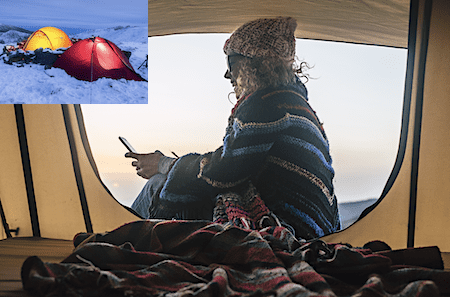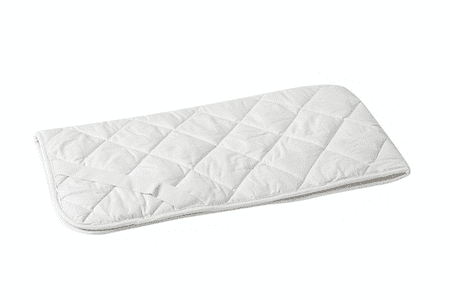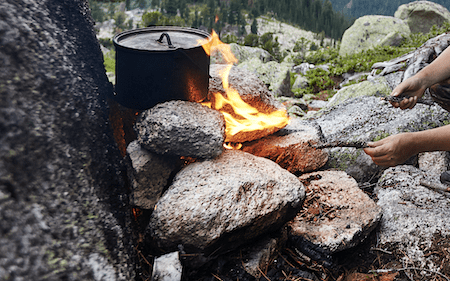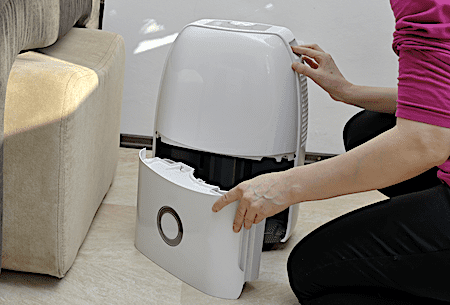Winter camping is a blast! It’s a great way to enjoy the winter and see the beauty of nature up close.
Yet, some challenges do come along with it — most notably, keeping your tent warm, since sleeping in a cold tent is like sleeping atop a snowbank.
Though I would argue that all-season alpine and four-seasons tents eliminate much of this fear, you still want to be comfortable even when the mercury plummets.
Keeping your tent warm while camping can sometimes be as easy as installing extra insulation or as complicated as modifying your sleeping bag with a DIY insulated liner.
Whatever you choose, check out our suggestions on how to keep a tent warm, so it stays comfy while you’re enjoying the great outdoors.
How To Keep Your Tent Warm?
The following tips will help you keep your tent warm during the winter or whenever it’s cold outside.
#1. Choose A Campsite Protected From The Wind
If you want to stay warm at night, picking the appropriate campsite is more important than anything else.
Ideally, you should choose a location away from the elements and wind. It should provide some shelter from heavy winds and thunderstorms.
However, a complete enclosure may not be ideal. After all, your tent must have good ventilation. The tent must be able to convey air to prevent moisture from accumulating.
Make sure you camp at a semi-sheltered location rather than in a cave with little air circulation.
#2. Use A Small Tent Instead Of A Big One
Heating smaller tents is always quicker and more straightforward than a big, giant one. The reason is a smaller tent has less surface area to radiate heat, while there is also less space for moisture to condense.
So, if you’re camping in a cold, wintery month, then going for a 12 person tent may not be your best option. It’d be a good idea to choose a tent only large enough to fit your needs.
#3. Bring A Tent Heater
Using a small propane heater during the night can warm up your tent within minutes. Propane heaters such as those from Mr. Heater are safe to use indoors.
It’s a good idea to set up a heater in your tent at the beginning of the evening. However, in enclosed spaces like tents, you should always use a heater with the utmost caution.
For instance, you should never leave the heater inside your tent while sleeping. As an alternative, you can heat your tent with a wood-burning stove.
But for that, your tent needs a stove jack designed for use with a wood stove.
#4. Keep Your Tent As Dry As Possible
The key to staying warm inside a tent is to keep the moisture out. The easiest way to do that is to make sure the outside of your tent stays dry, so you want to set up your campsite on a hill or in another sheltered spot where you’re unlikely to be rained on.
Because it’s impossible to avoid all moisture, you’ll also want to make sure that everything that can get wet is either made of synthetic fibers, like a Gore-Tex jacket (which will still work even if it gets soaking wet) or sealed in a plastic bag.
Unless you waterproof your tent, if it does get wet, either because of rain or condensation, the most important thing is to get the water out as quickly as possible before it has time to soak into the fabric.
That means opening any windows or doors and using fans or a hairdryer if you have one available. It’s easier to dry out a tent when it’s completely intact than when you’re trying to sleep inside of it.
#5. Insulate Your Tent With Blankets
It isn’t always necessary to use a gas heater or stove to keep a tent warm! When you start adding your own body heat to an adequately insulated tent, it can practically heat by itself.
A simple yet effective approach is to bring a few blankets and spread them out around the tent. Mylar blankets will be ideal for this task since they trap heat well, but any blanket should do.
You can line the blankets up along each corner and lay them flat on the floor. And after that, you can weigh them down with your excess gear to secure them in place.
Just be sure to take your boots off before going inside the tent. Additionally, you should stow wet clothing in plastic bags so that your blanket-lined tent stays dry.
#6. Lay An Insulated Pad Under The Tent
Even with the blankets lying on the tent’s floor, insulating the ground from you can be quite helpful in preventing heat transfer. And using a tarp under your tent is a good DIY option to try.
Also, you can make yourself more comfortable by placing some leaves underneath the tarp. Just lay down as many leaves as possible where you intend to place the tarp.
The layer of leaves between the ground and the tent serves as an excellent insulator.
#7. Heat Some Rocks
Even if you do not have the option to bring a heating device to your campsite, you should still be able to keep your tent warm. All you have to do is heat a few rocks.
Using hot rocks to heat is a clever hack that few are aware of. But it’s pretty much a no-brainer since you’ll most likely have a campfire to heat some rocks.
Bringing them into your tent will enable them to radiate heat once you heat them well. However, you must be very cautious when using this technique.
If the rocks are too hot, they may burn you or cause your tent to melt. It’s a good idea to wrap the rocks with a towel when handling them to cut the dangers without a hitch.
#8. Use A Hot Water Bottle
Heating a tent with hot water bottles is similar to using hot rocks. Some hot water bottles radiate heat exceptionally well inside a tent, as you’ll find out when you use them.
The technique involves heating water in hot bottles before bringing them inside your tent. This trick also comes in handy when you want to keep the inside of your sleeping bag comfortably warm on a cold night.
You can easily place a hot bottle inside a sleeping bag by wrapping a towel around it beforehand. But be sure to touch it first and ensure that it won’t burn you.
#9. Make Room For Ventilation
Maintaining good ventilation in your tent seems counterintuitive to insulating it. So, why would you want a drafty tent?
The thing is, when you seal up a tent tightly, it will prevent any moisture from escaping. The tent and everything in it will condense all of this moisture by morning.
As a result, you’ll wake up wet and so will your clothes. That’s certainly not very warm and comfortable. When you wake up wet, you’ll be cold the rest of the day.
So, you must ensure your tent has good ventilation. For instance, if the wind isn’t biting, you can keep the mesh windows partially open.
How To Stay Warm Inside A Tent
As obvious as it may seem, keeping yourself warm inside a tent is just as crucial as trying to keep the tent warm itself when it comes down to keeping things comfortable.
Here are a few tips on how to keep yourself warm inside your tent.
#1. Dress Warm In Layers
Dress warm to impress if you’re going camping in cold weather. Wearing layers of clothing—base and mid-layers, shell jackets, and puffies—allows you to regulate your body temperature more effectively.
Throughout the day, you will work up a lot of body heat. During this process, you must avoid sweating because sweat cools when it dries, making you feel as cold as ice.
Maintaining a constant body temperature by constantly removing and adding layers of clothing prevents you from sweating too much, which is essential to staying warm in the winter.
#2. Put On Fresh Clothes For Sleeping
Start the day with clean clothes by putting on fresh ones before sleeping. After all, it will almost be impossible to stay dry with sweaty clothes at the start of the night. And inevitably, you won’t stay warm when you’re not dry.
A quick change of clothes in your sleeping bag just before bed is a great idea. Your sleeping bag will get warm from your body heat if you move around while inside it.
In this way, you can start the night off warm. Also, you should never sleep in wet clothes while camping in the rain.
#3. Use Hand And Foot Warmers
You can keep your hands and feet warm effortlessly by using chemical hand and foot warmers. They can last between eight and ten hours, meaning they can last all night long.
Try putting a pair on an hour before you plan to sleep if you get cold hands or feet quite often. By doing so, you can warm them up in time for bed so they won’t be too hot after you sleep.
#4. Warm-Up Before Going To Bed
You will most likely remain cold for a substantial portion of the night if you go to bed cold.
That’s why, right before sleep, you should raise your blood flow rate and your inner body temperature by walking or exercising – a session of star jumps, push-ups, running on the place, or burpees should be enough.
#5. Invest In A High-Quality Sleeping Bag
If you’re just going camping in chilly weather, any sleeping bag along with the tips above should keep you quite warm.
But you’ll need a sleeping bag specially designed for cold-weather camping if you’re going to go camping in freezing temperatures.
When choosing the perfect cold-weather sleeping bag, you will need to keep your camping area’s temperature in mind. Ideally, you’ll want one with the best rating for a specific temperature range.
Unfortunately, however, these ratings aren’t always reliable! In general, they can be off by 10 to 15 degrees.
Thus, if the sleeping bag you’re considering has a rating of 20-25 degrees, then you should get one in the 10-15 degree range.
Also, try to go for down sleeping bags if you can afford them. They’re more than worth the added cost compared to their synthetic substitutes.
#6. Use A Sleeping Bag Liner
If you want to add an extra layer of insulation to your sleeping bag, you can pair it with a sleeping bag liner or blanket.
Also, liners can be incredibly helpful if your sleeping bag isn’t quite warm enough for the outside cold. But make sure that the liner material you select is breathable.
Avoid anything made from cotton, which will soak up moisture and make you wet and cold throughout the night.
#7. Have A Warm Drink And A Hearty Dinner Before Bedtime
Consuming food constantly keeps your body’s internal furnace running and burns calories to keep you warm.
The higher the fat and protein content of the meal, the longer it will hold you sustained and warmed up. Your body may require as much as 6,000 calories each day when hiking in the winter cold.
Your body’s ability to cope in the cold also relies on your body’s ability to hydrate. Keeping hydrated minimizes fatigue, too. In contrast, getting dehydrated only makes it harder for you to stay warm.
Even if the water you drink makes you go out in the middle of the night, you shouldn’t drink less. The trip outside is worthwhile since your body warms up the liquid inside your bladder.
#8. Use A Dehumidifier
In cold temperatures and high humidity inside the tent, our bodies radiate heat more readily and easily, which causes us to become colder more quickly.
Hence, you might want to consider bringing a dehumidifier because it can significantly reduce the humidity inside the tent and maintain your body temperature.
Lastly, you can use candles to heat up the tent. Lowering 2-3 degrees Fahrenheit can make a huge difference.
Thoughts
Having a tent that can’t keep the cold out can end up being a disaster when camping in the winter. That’s why keeping warm is so crucial to having a satisfying winter camping experience.
No matter how overpacked you are on blankets, clothes, or other insulating items, you can only make the best use of them when you know how to keep a tent warm properly.
But now that you know everything there is to know, you shouldn’t have a problem getting a good night’s sleep in your tent, even when it’s cold outside.
Besides winter, are you prepared for summer camping? Don’t forget to learn the ways to cool a tent without electricity.

